Key takeaways:
- DIY natural cleaners are effective, cost-effective, and utilize non-toxic ingredients, promoting a safer home environment.
- The environmental impact of conventional cleaners is significant, contributing to pollution and waste due to harmful chemicals and plastic packaging.
- Creating DIY cleaners offers a sense of accomplishment and allows for creativity, transforming cleaning into an enjoyable and eco-friendly practice.
- Preparation and mindfulness enhance the cleaning experience, making it feel less like a chore and more like a fulfilling activity.

Understanding DIY natural cleaners
DIY natural cleaners are solutions made from simple, often food-grade ingredients that can effectively tackle everyday cleaning tasks. I vividly remember the first time I mixed vinegar and baking soda for a kitchen cleaner; the reaction was like a mini science experiment! I was intrigued not just by its effectiveness, but also by the idea that I was using non-toxic materials, making my home safer for my family.
When I think about the shift from commercial cleaners to DIY options, it’s empowering. Have you ever scrutinized an ingredient list on a conventional cleaner? I was shocked to find substances I couldn’t even pronounce. This realization pushed me to experiment with essential oils and herbs, which not only cleaned but also provided a delightful aroma. Crafting my own natural cleaners felt like reclaiming control over my surroundings, and I soon became excited about the process.
Understanding DIY natural cleaners also involves recognizing their environmental impact. Using ingredients like lemon juice and vinegar means reducing chemical waste that often ends up in our waterways. I once calculated how much plastic I cut down by creating my own cleaners, and it felt rewarding. It’s more than just cleaning; it’s a conscious choice to help the planet. Why wouldn’t you want to be part of that change?
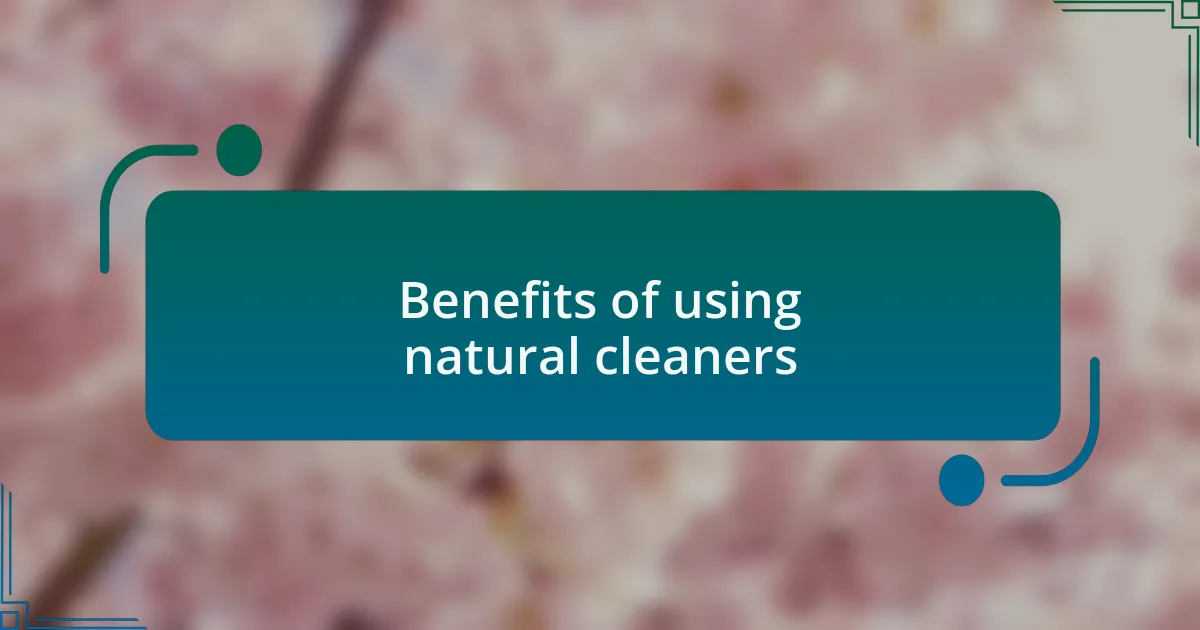
Benefits of using natural cleaners
Switching to natural cleaners has been a game changer for my household. Not only do they work just as well, if not better, than their commercial counterparts, but I also find comfort in knowing that I’m not exposing my family to harmful toxins. Just the other day, I made a simple all-purpose cleaner with white vinegar and essential oils, and it left the kitchen smelling fresh and inviting, unlike the overpowering scent of store-bought products.
One of the most surprising benefits I’ve discovered is the cost-effectiveness of DIY natural cleaners. I used to spend a significant amount on cleaning supplies, but now I rely on basic ingredients that I often already have at home. This shift not only lightens my wallet but also reduces waste generated from packaging. Have you calculated how much you could save? It’s substantial when I look back at my receipts from those cleaning aisles.
Then there’s the joy of creating something yourself. Each time I whip up a batch of natural cleaner, I feel a sense of accomplishment. It’s like a little victory in a busy day. My favorite moment was when a friend complimented my homemade lemon-scented spray, not knowing it was a simple combination of lemon juice and water. I realized then that sharing my journey could inspire others to make similar choices, fostering a community of eco-conscious individuals. Wouldn’t it be wonderful if we all shared this passion?
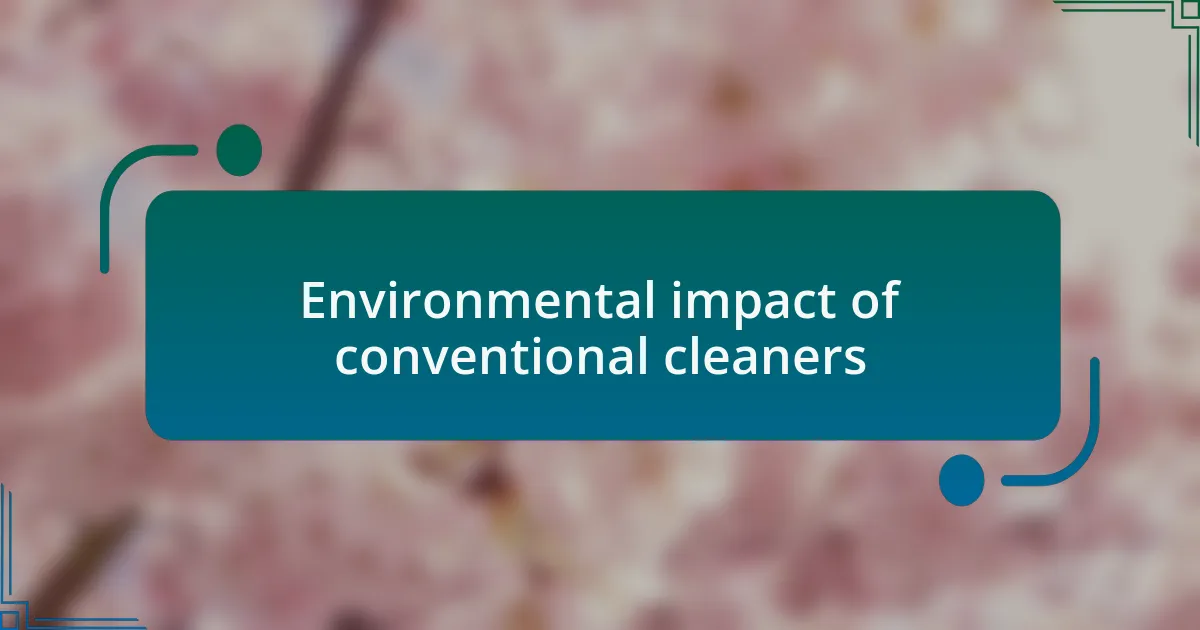
Environmental impact of conventional cleaners
The environmental impact of conventional cleaners is significant and often overlooked. Many of these products contain harmful chemicals that not only pollute our indoor air but also find their way into our waterways, affecting wildlife and ecosystems. I remember the first time I realized that the cleaner I was using could potentially harm fish in a nearby stream; it hit me hard and made me rethink my choices.
Moreover, the manufacturing and disposal of conventional cleaners contribute to waste and greenhouse gas emissions. These products often come in single-use plastic containers that end up in landfills. It’s disheartening to think that my cleaning routine was adding to a growing pollution problem. Have you ever looked at your cleaning product containers and thought about their journey after use?
Even more troubling is that many conventional cleaners include phosphates and surfactants, which can lead to algal blooms in water bodies. When I learned this, I felt responsible for my part in a cycle that harms our environment. There’s something unsettling about using a product that may unknowingly contribute to the degradation of beautiful places we cherish. So, what can we do? Taking small steps towards eco-friendly alternatives is a great start.
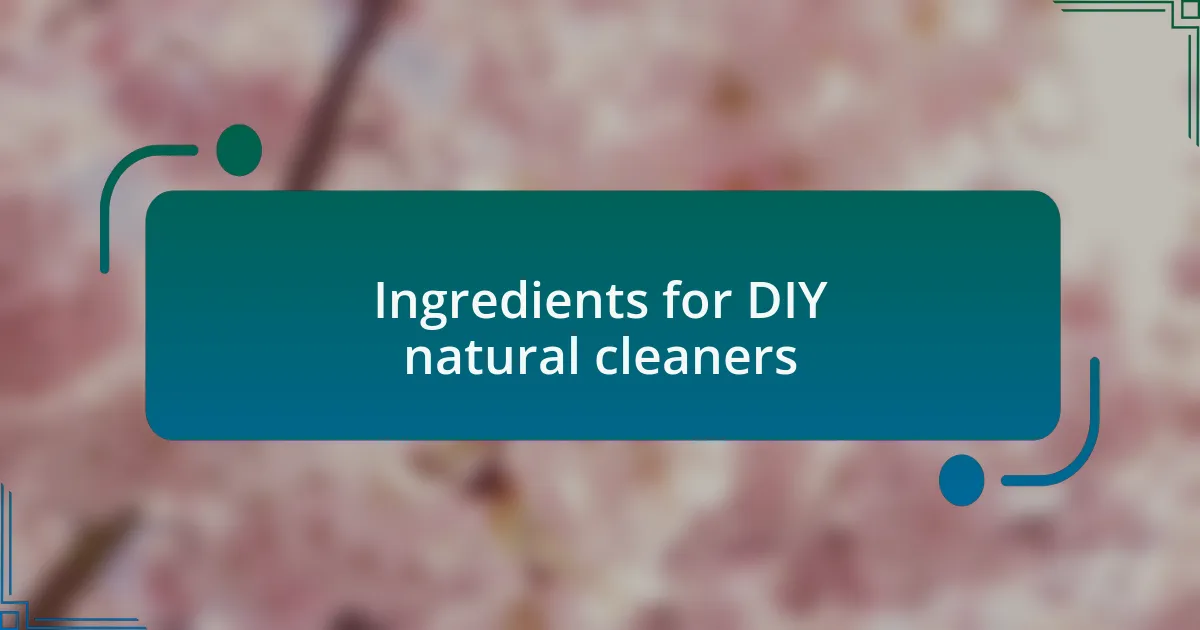
Ingredients for DIY natural cleaners
When it comes to creating DIY natural cleaners, the ingredients play a pivotal role. I’ve found that basic household items like vinegar, baking soda, and lemon juice can transform into powerful cleaning agents. The first time I used a simple mixture of vinegar and water, I was amazed at its ability to cut through grime—it was a “lightbulb” moment that made me realize cleaning could be both effective and safe.
In my experience, essential oils can elevate your cleaners not just with their scents but also with their properties. For instance, tea tree oil is known for its antimicrobial effects. I remember making a customized cleaning spray infused with eucalyptus oil; the fresh aroma filled my space, making cleaning feel less like a chore and more like a soothing ritual. Have you ever noticed how a pleasant scent can change your mood while cleaning?
Using natural ingredients is straightforward, but understanding their properties can enhance their effectiveness. The reaction between baking soda and vinegar, for example, creates a powerful fizzing action that breaks down tough stains. I still chuckle when I think about my initial attempts at mixing them— the fizz was so intense that it felt like my cleaning job was a little science experiment! It’s these fun moments that remind us that eco-friendly cleaning can also be enjoyable.
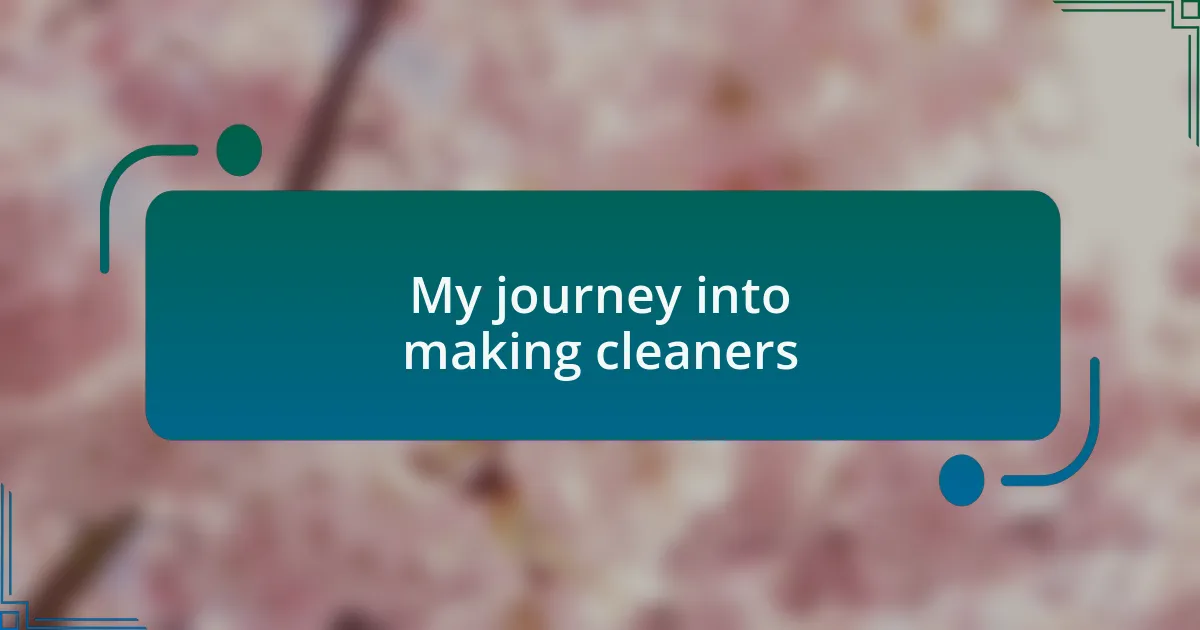
My journey into making cleaners
As I ventured into making my own cleaners, the process felt like rediscovering a forgotten art. The first time I combined my ingredients, standing in my kitchen surrounded by jars and bottles, I can still recall the blend of excitement and nervousness. Would this concoction work? Was I really about to replace store-bought cleaners with my homemade versions?
One day, I decided to tackle my bathroom, armed with a paste of baking soda and water. When I scrubbed the tiles and saw the dirt lift away, a sense of accomplishment washed over me. I remember feeling like an alchemist, transforming simple ingredients into something effective and fresh. It dawned on me that the act of cleaning could be empowering, driven by sustainability and my own creativity.
The process was not always seamless, though. I vividly recall a time when I experimented with a new formula involving vinegar and dish soap. The smell was overwhelming and not pleasant at all! What did I learn? Each failure taught me something valuable about balancing scents and effectiveness. Have you ever felt the thrill of trial and error in your own home experiments? Each mishap simply fueled my desire to refine my approach, proving that the journey of making natural cleaners is a perfect blend of discovery and growth.
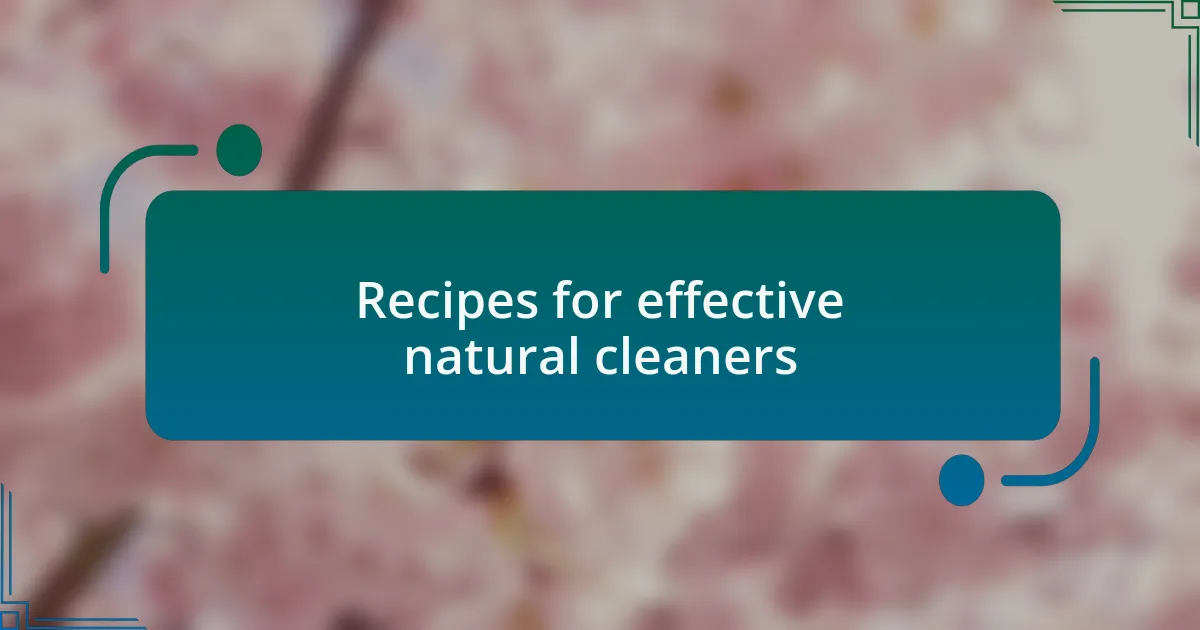
Recipes for effective natural cleaners
When it comes to effective natural cleaners, I’ve found that a few classic recipes truly shine. One of my favorites is a simple all-purpose cleaner made from equal parts of white vinegar and water, with a few drops of essential oil for a pleasant scent. It’s incredible how just a few basic ingredients can tackle everything from kitchen counters to bathroom surfaces, leaving everything sparkling clean. Have you given it a try?
Another standout recipe in my cleaning arsenal is the trusty baking soda scrub. I mix three parts baking soda with one part liquid castile soap, and sometimes I add a splash of lemon juice for an extra boost. The combination creates a paste that works wonders on tough stains and grime. I remember one instance where it completely transformed my grimy oven—what a relief it was to see it shine again!
If you’re looking for a natural glass cleaner, I can’t recommend mixing water, vinegar, and cornstarch enough. This formula not only leaves windows streak-free but also makes the cleaning experience less daunting—no more harsh chemical fumes to contend with. I still smile at the memories of cleaning my windows, feeling the sun warm my face as I made my space brighter and more inviting. Each recipe I’ve tried has not only been effective but has also deepened my connection to the spaces I inhabit. What simple ingredients do you have in your home that you could turn into your own cleaning solutions?
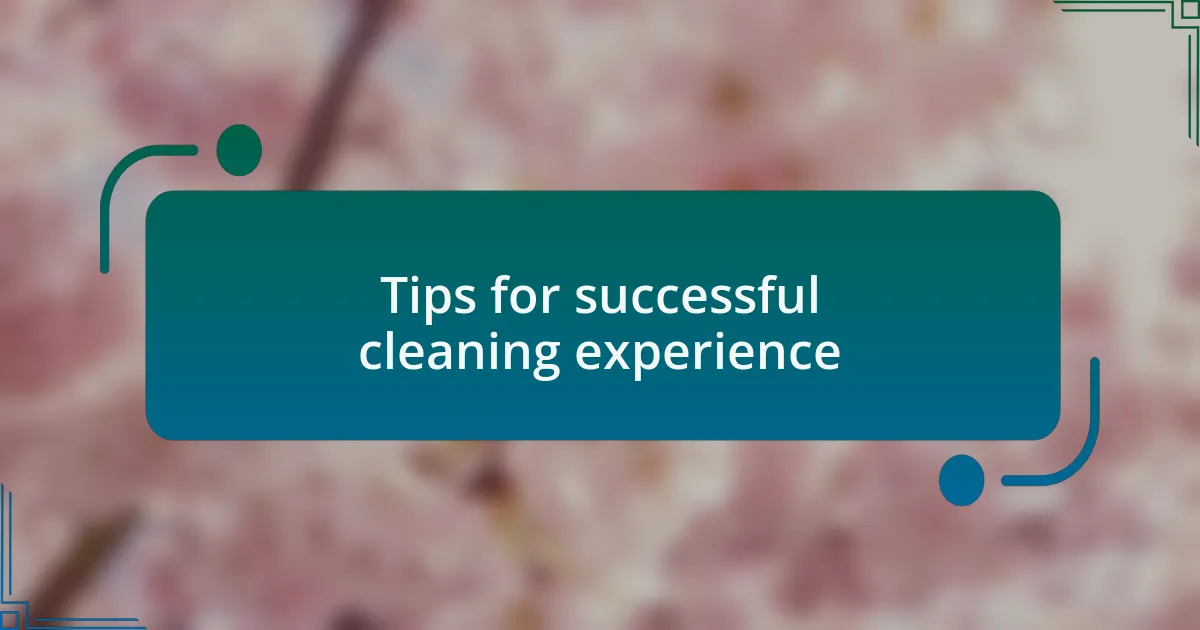
Tips for successful cleaning experience
When diving into a cleaning session, I’ve learned that preparation is key to a successful experience. I always gather all my supplies ahead of time, laying them out on a clean surface. It feels almost ritualistic, like preparing for a small adventure, and it helps prevent the frustration of repeatedly searching for that elusive sponge or cloth mid-cleaning. Have you ever found yourself in a cleaning spree, only to stop and hunt for a missing cleaner?
Moreover, setting a specific time for your cleaning task has significantly improved my motivation. I like to think of it as scheduling “me time” with my home. During this dedicated time, I can fully focus without distractions, allowing me to enjoy the process rather than viewing it as a chore. Have you ever set a timer for cleaning? It turns the task into a game, making it less overwhelming and more engaging.
Finally, embracing a mindset of mindfulness transforms my cleaning experience entirely. As I scrub surfaces or wipe down shelves, I often take a moment to appreciate the space around me. This practice not only enhances my connection to my home but also turns cleaning into a meditative exercise. When was the last time you truly appreciated the surfaces you clean? It’s incredible how a little gratitude can change the energy of the task and leave you feeling rejuvenated.